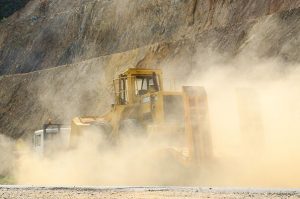In an era where workplace safety is paramount, OSHA‘s silica standard aims to protect millions of workers from the hidden dangers of respirable crystalline silica, ensuring a healthier future across various industries.
In an effort to create more uniformity for the enforcement of silica standards, OSHA published an instructional inspection procedures for compliance safety and health officers.
This directive aims to standardize enforcement across various industries, including construction, general industry, and maritime operations.
The new “playbook” went into effect June 25, 2020, and remains a crucial component of silica enforcement guidance.
So, what do you need to know? Let’s check out a breakdown of OSHA’s guidance on how to enforce the updated silica standard requirements.
Related Article: Breaking Down the Silica Physical Exam
Related Article: New OSHA Initiatives to Combat Silica Exposure in Engineered Stone Industry.
Overview of the Silica Enforcement Guidelines
The June 2020 directive outlines comprehensive inspection procedures that focus on multiple aspects of silica exposure. Key areas of guidance include:
– Methods of Compliance: Employers must implement effective strategies to control silica exposure.
– Exposure Assessments: Regular evaluations are necessary to determine employee exposure levels.
– Table 1 Tasks: Specific tasks and corresponding exposure control methods are detailed in Table 1.
– Housekeeping: Proper cleaning practices must be established to minimize silica dust.
– Communication of Hazards: Employers must inform workers about the risks associated with silica exposure.
– Respiratory Protection: Adequate respiratory protection must be provided where necessary.
– Regulated Areas: Designated areas should be established where silica exposure is monitored and controlled.
– Recordkeeping: Employers are required to maintain accurate records of exposure assessments and training.
– Employee Information &Training: Workers must receive training on silica hazards and protective measures.
– Medical Surveillance: Regular health checks for exposed employees are now mandatory.
The directive also clarifies alternative control methods for construction employers who may not fully implement Table 1. It addresses variability in sampling, multi-employer scenarios, and protections for temporary workers.
The agency’s press release states, “The directive also provides clarity on major topics, such as alternative exposure control methods when a construction employer does not fully and properly implement Table 1, variability in sampling, multiemployer situations, and temporary workers.”
– See OSHA publication on Inspection Procedures for the Respirable Crystalline Silica.
Key Takeaways for Employers
The updated silica standard maintains a permissible exposure limit (PEL) of 50 micrograms per cubic meter (µg/m³) averaged over an 8-hour workday. Notably, all general industry and maritime employers must now provide medical surveillance for employees exposed at, or above, the action level of 25 µg/m³ for 30 or more days annually.
This marked an update from the previous rule that required medical surveillance be made available only to workers who had exposure above the permissible exposure limit for 30 or more days per year.
Employers are encouraged to utilize the compliance checklists found in Appendix F of the guidance. These checklists offer step-by-step instructions segmented by industry type—construction, general industry, and maritime.
By incorporating these tools into safety programs, you can proactively address potential issues before OSHA inspections occur.
Make sure you incorporate these into the safety compliance programs and utilize them to simulate OSHA inspections on your worksites, and take corrective action before the real inspection arrives.
Special Considerations for Hydraulic Fracturing
The updated guidance also included specific protocols for hydraulic fracturing operations.
Appendix G outlines inspection guidelines tailored for the oil and gas industry, emphasizing engineering controls necessary to limit silica dust exposure. Compliance with these updated requirements is crucial for maintaining worker safety in this high-risk sector.
To schedule your mobile silica physical exams & respirator fit testing, complete the form below.
Importance of Compliance
OSHA’s emphasis on enforcing these updated standards stems from the serious health risks associated with respirable crystalline silica. Inhalation of silica dust can lead to severe conditions such as silicosis, lung cancer, chronic obstructive pulmonary disease (COPD), and kidney disease.
Approximately 2.3 million workers in the U.S. are exposed to silica on their jobs, highlighting the urgent need for effective safety measures.
Challenges
Despite the directive, challenges remain in ensuring compliance across diverse workplaces. Employers must navigate complex situations involving multi-employer job sites and temporary workers while adhering to stringent regulations.
The ongoing evolution of OSHA‘s standards reflects a commitment to worker safety, but also presents hurdles for organizations striving to meet compliance requirements.
Bringing it Together
OSHA’s instructional procedures for silica standards represent a critical step toward uniformity in workplace safety enforcement.
By understanding and implementing these guidelines, you can protect your workers from the dangers associated with respirable crystalline silica.
Regular training, thorough recordkeeping, and adherence to compliance checklists will be essential in fostering a safe working environment as industries adapt to these new regulations.
To schedule your mobile silica physical exams & respirator fit testing, complete the form below.
***
About Worksite Medical
In most cases, OSHA requires medical surveillance testing, and at no cost to employees.
Worksite Medical makes that program easier with mobile medical testing.
We conduct silica exam physicals, on-site respirator fit tests (including N95 masks), audiometric exams, as well as pulmonary function tests and heavy metal lab work, right on your job site. We also keep accurate, easy-to-access medical records for your convenience. You’ll keep your employees at work, and stay ahead of OSHA inspections.
With Worksite Medical, a mobile medical testing unit — we can bring all the resources of a lab to you. Our certified lab technicians can perform both qualitative and quantitative respirator tests to ensure a perfect fit.
Protect your team and your workplace now with Worksite Medical. Not sure what you need? Try our medical testing wizard here.
Give us a call at 1-844-622-8633, or complete the form below to schedule an on-site visit or to get your free quote!




